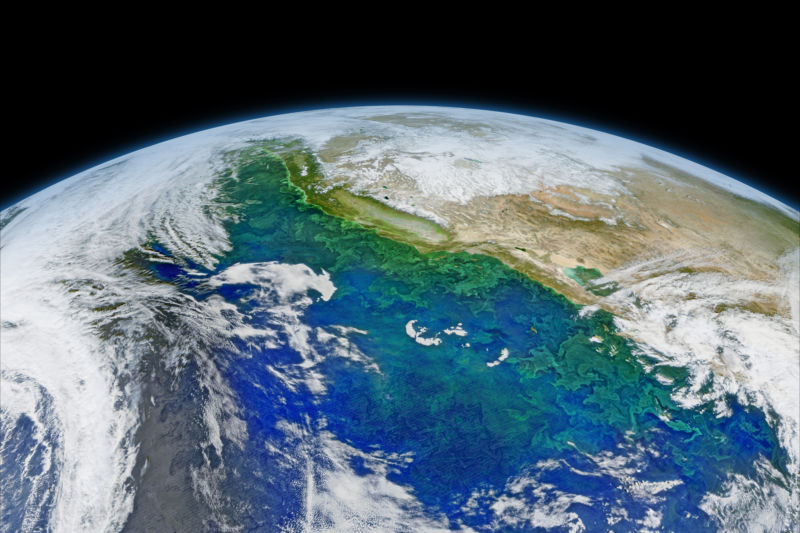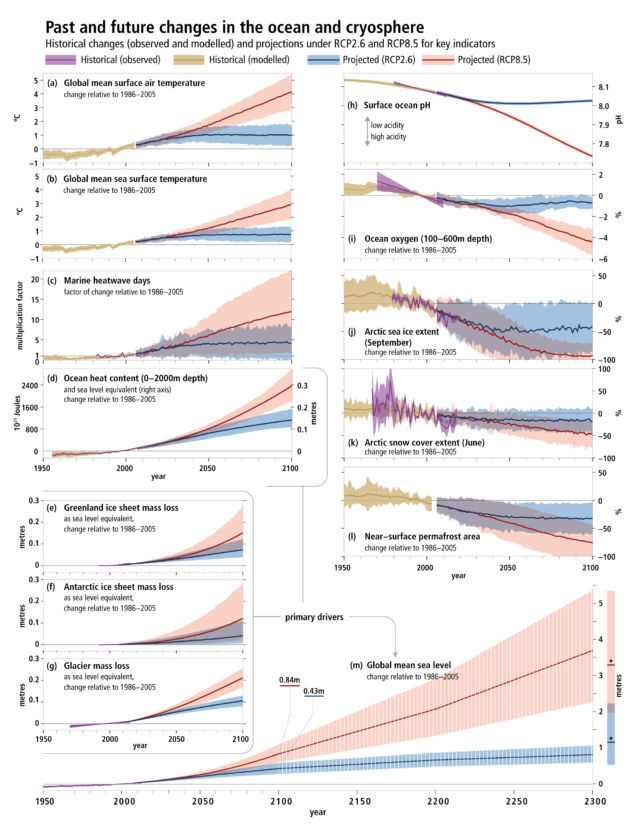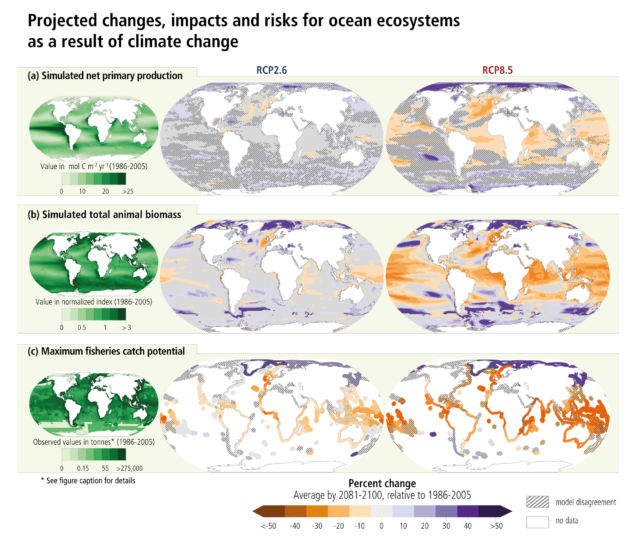
“Over the 21st century, the ocean is projected to transition to unprecedented conditions with increased temperatures, greater upper-ocean stratification, further acidification, oxygen decline, and altered net primary production.” That’s one of the top-line conclusions detailed in a new IPCC report released Wednesday. This latest report—the volunteer work of over 100 scientists summarizing almost 7,000 published studies—focuses on our planet’s ocean and cryosphere, describing the changes we’ve measured, projected future changes, and the choices before us.
The report follows on others covering the potential benefits of limiting warming (which has already reached 1°C) from exceeding 1.5 °C, the role of land use in climate change, and impacts on global biodiversity.
The observed changes in oceans and ice run the gamut from physical changes to chemistry to living things. Sea levels are rising at increasing rates, of course, but it’s also true that marine heatwaves (the kind of event that can bleach coral reefs) have doubled in frequency over the last few decades, and oxygen availability has slightly declined in the surface ocean as circulation changes. Marine species have shifted their geographic ranges to track changing conditions, and sea-level rise combined with coastal habitat loss have boosted flooding events and the inland intrusion of saltwater.
On land, mountain glaciers are shrinking and snowpack is declining in key areas. In the Arctic, permafrost is thawing, accompanied by infrastructure damage on suddenly unstable ground and an increase in wildfires. All these changes have consequences for humans and other species.

The report also summarizes and updates projections for future changes. In many cases, it highlights the difference between rapid emissions cuts (limiting warming to 2°C) and a high-emissions scenario that would see the world warm by more than 4°C. The sea-level-rise projections, for example, are slightly higher than in the 2013 IPCC report, reflecting increased confidence in our understanding of Greenland and Antarctica. Compared to the 1986-2005 average, the report projects around 43 centimeters (1.4 feet) of additional sea-level rise by 2100 in the low-emissions scenario and 84 centimeters (2.8 feet) in the high-emissions scenario. (Those are average estimates—greater amounts of sea-level rise are possible. And in either case, sea level is likely to tick upward for centuries to come.)
It’s also projected that roughly 25% of the world’s permafrost could thaw by 2100 in the low-emissions scenario, with that number increasing to 70% in the high-emissions scenario. That will result in additional CO2 (and some methane) added to the atmosphere—equivalent to years’ worth of current global fossil fuel emissions in the high scenario.
Elsewhere in the Arctic, the report highlights the fact that “sea-ice-free” conditions during the late summer would be about a once-per-century event if we could halt global warming at just 1.5°C. Even at 2°C, however, the odds would shoot up to one-in-three.
The projected changes are expected to affect water resources in mountainous areas reliant on snow and glacial meltwater, including hydroelectric power generation. Many coastal areas, on the other hand, will have to be concerned with water rising. On top of sea-level trends, the report notes that tropical cyclones are producing greater rainfall and storm-surge flooding events.
Much of the report deals with trends relevant to marine life. Rising temperatures and falling pH (caused by increasing atmospheric CO2), along with circulation changes, threaten many species that are already suffering from human activities like overfishing. Compared to the last few decades, the report projects that a high-emissions scenario would result in a sobering 15 (±6) percent drop in marine-animal biomass. The maximum potential catch of fisheries would drop 20-24%.

Marine losses would actually be greatest in the tropics, with a more complex pattern near the poles as life moves into new areas that open up. Some high-latitude fish species, for example, may expand into the Arctic, while the range of species native to the Arctic contracts.
Now what?
None of these things is surprising to those who have been paying attention, but the details in the report provide the latest science. That’s true not just for the problems but for the solutions, as well.
The report lays out a laundry list of challenges and opportunities. Chief among them is eliminating greenhouse gas emissions and halting climate change. That step is a requirement, but there are also other actions that steer us toward a better future.
As the oceans are intrinsically international, increased cooperation among nations will be necessary. Designating (and enforcing) marine protected areas can give communities of species a refuge in which to stabilize, away from the onslaught of overfishing. Along the coasts, habitat restoration can regrow the wetlands that buffer storm waves. That kind of adaptation will help protect human communities from the worst impacts of sea level rise.
“Prioritizing measures to address social vulnerability and equity underpins efforts to promote fair and just climate resilience and sustainable development and can be helped by creating safe community settings for meaningful public participation, deliberation, and conflict resolution,” the report states. “This assessment of the ocean and cryosphere in a changing climate reveals the benefits of ambitious mitigation and effective adaptation for sustainable development and, conversely, the escalating costs and risks of delayed action.”
https://arstechnica.com/?p=1574937

